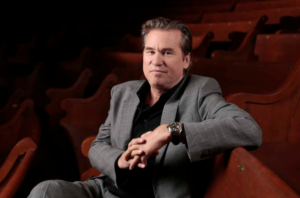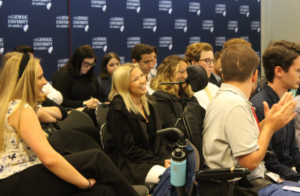Rediscovering the Renaissance: The First Spanish Sculptor

Image courtesy of Anna Harvey
By Anna Harvey
Religious artwork takes a bold and stunning new approach at the National Gallery of Art’s new exhibition of Alonso Berruguete: First Renaissance Sculptor of Spain. The exhibition is comprised of two rooms of 40 works, consisting of paintings, drawings, and sculptures. The exhibition opened October 13, 2019, and will remain open until February 17, 2020.
The most striking piece at the center of the first room is Berruguete’s Ecce Homo, or “Behold the Man.” Upon a first glance at the sculpture, Jesus Christ makes direct eye contact with the viewer, as he stands in humiliation just after being stripped of his garments and crowned with thorns.
“Instead of following tradition and covering Christ’s body with scourge marks and blood, Berruguete elicits sympathy from the viewer through other means” states the National Gallery’s description of the sculpture.
This aspect of Ecce Homo is present in other examples of Berruguete’s art, where an emphasis is put upon the sculpture’s facial features and their style of clothing to elicit an emotional response from the viewer.
Just behind Ecce Homo stands a large sculpted wooden altarpiece, or retablo, with inlaid sculpted figures and paintings, such as Saint John the Baptist, Saint Matthew, and Saint Augustine of Hippo. This unique combination of both painting and sculpting not only provokes a sense of lifelike majesty but also gives insight into several of the religious figures admired in Berruguete’s time.
In the second room stands several disassembled pieces of a larger wooden, sculpted retablo. The most notable of the sculptures depicts the Crucifixion, with Mary and Saint John flanking the cross. The scene itself conveys a sense of magnanimity through the stark contrast of Christ’s pale and deathly appearance with the gilded garments of Mary and Saint John. On opposite sides of the room sit two additional components of the retablo. One appears to be the pinnacle of the altarpiece, with two Grecian soldiers sitting atop a painted wooden frame with two muses directly underneath. The other component consists of several smaller sculptures, such as Saint Christopher and The Sacrifice of Isaac, which would adorn the retablo.
Alonso Berruguete is one of the first acknowledged Renaissance painters and sculptors from Spain. Originally from Castile, he particularly uses the Hispano-Flemish style unique to this area, which not only reflects certain aspects of northern European art but also utilizes certain Gothic features. Additionally, he combined this detailed Hispano-Flemish style with features from the Italian Renaissance, as seen in his retablos. Furthermore, Berruguete became the first Spanish artist to produce a cohesive assortment of drawings, a selection of which is also displayed at the exhibition among the sculptures.The exhibition of Alonso Berruguete: First Renaissance Sculptor of Spain reminds the viewer that art is not simply adherence to current artistic conventions, but it can also combine techniques and styles from different artistic movements. The combination of Hispano-Flemish, Gothic, and Italian Renaissance styles retains traditional aspects of religious art while likewise making it a personal and emotional experience for the viewer.








